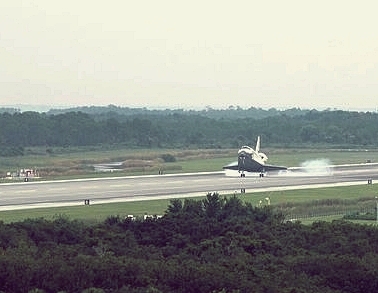
 |
![]() Image choisie: La Seconde Mission de Retour au Vol atterrit au Kennedy Space Center
Image choisie: La Seconde Mission de Retour au Vol atterrit au Kennedy Space Center
La Seconde Mission de Retour au Vol de la navette spatiale atterrit sur la piste 15 du Shuttle Landing Facility du Kennedy Space Center, en Floride. Lorsque vient le moment de revenir sur Terre, la navette spatiale accomplit ce que l'on appelle un "deorbit burn", une mise à feu de ses moteurs à fins de quitter l'orbite. L'action des moteurs, en effet, ralentit la navette sur l'orbite et elle quitte tout naturellement celle-ci. Ensuite, on a à faire à un long vol plané jusqu'au site de l'atterrissage. Ce qui explique que le "deorbit burn" a lieu loin en amont du site. Dans le cas d'un atterrissage en Floride, la mise à feu des moteurs se fait au-dessus de l'Océan Indien! Tout au long de la descente, l'équipage n'a plus aucun moyen d'intervenir sur la trajectoire... La Seconde Mission de Retour au Vol, la mission STS-121 de la navette spatiale, avait pour but de continuer d'évaluer l'aptitude de la navette à reprendre des vols dans l'espace, suite à la perte de la navette Columbia en février 2003. Il s'agissait ainsi de tester les améliorations et les procédures adoptées après l'accident. La première Mission de Retour au Vol avait été problématique: la question récurrente des débris de mousse isolante du réservoir extérieur était, une fois de plus, venue interférer. La mission STS-121, au contraire, n'a pas connu ces problèmes et l'inspection du bouclier thermique après l'atterrissage n'a fait montre d'aucune anomalie. La piste du Shuttle Landing Facility du Kennedy Space Center est la piste que les navettes utilisent habituellement lors de leur retour sur Terre. En cas de problème, deux autres pistes sont à disposition de la navette: celle de la Edwards Air Force Base, en Californie et celle du White Sands Space Harbor, au Nouveau-Mexique. NASA-KSC